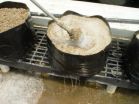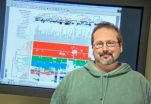(Press-News.org) TOLEDO, OH—In parts of the United States where ornamental and vegetable plants are produced in greenhouses during cold seasons, heating costs are second only to labor costs for greenhouse operators. Greenhouse growers are faced with important management decisions that rely on understanding how temperature settings, heating systems, fuel types, and construction decisions influence their heating costs. To address the lack of user-friendly computer programs currently available for calculating heating costs in greenhouse operations, scientists have created a state-of-the-art system they call "Virtual Grower".
"Virtual Grower was designed to help calculate heating costs at many U.S. sites," said Jonathan Frantz, a researcher with the USDA-Agricultural Research Service. The program uses a weather database of typical hourly temperature, light, and wind information of 230 sites from the National Renewable Energy Laboratory. Frantz and colleagues Bryon Hand, Lee Buckingham, and Somik Ghose reported on their cost-saving program in HortTechnology.
Highlights of Virtual Grower are features that allow users to define unique design characteristics such as building material and construction style. "Users can also define the type of heating system and heating schedule; the program will then predict heating costs based on typical weather at the selected location", Frantz said. Using the 'Add New Greenhouse', button on the site, values are automatically populated for greenhouse name, length, width, knee wall height, materials, fuel types, infiltration, and heating system efficiency. Users can change the values in drop-down windows or describe the house in more detail through additional buttons on the screen. The program also features methods for estimating typical commercial-scale heating system efficiencies and air infiltration values.
The team has plans to enhance the capabilities of Virtual Grower. "Adding plant growth and development models will allow for scheduling and an assessment of plant quality, while improving the realism in heating systems and partitioning of greenhouses would provide more realistic simulation opportunities," they said. "Carbon footprints could be calculated from the existing software's framework, and predictions of plant pest outbreaks and water use could also be folded in, with linkages to the historical weather database already used."
"Continued development will improve the software and allow users to perform baseline analysis of their heating costs, identify areas in their production to improve efficiency, and take some of the guesswork out of energy analysis in greenhouses", Frantz said.
###
The complete study and abstract are available on the ASHS HortTechnology electronic journal web site: http://horttech.ashspublications.org/cgi/content/abstract/20/4/778
Founded in 1903, the American Society for Horticultural Science (ASHS) is the largest organization dedicated to advancing all facets of horticultural research, education, and application. More information at ashs.org
New software calculates heating costs in greenhouse operations
Program designers say Virtual Grower can 'take the guesswork out of energy analysis'
2011-03-18
ELSE PRESS RELEASES FROM THIS DATE:
Recycling perlite: New, improved method saves resources
2011-03-18
BOSSIER CITY, LA—Perlite, a processed volcanic mineral, is widely used as a component of soilless growing mixes. Lightweight, sterile, and easy to use, perlite is popular with greenhouse growers. But because salt and pathogen buildup can occur when perlite is reused, it must be replaced every year or two to minimize the risk of crop failure. The cost of disposing of old material and replacing it with new perlite can be significant and often prohibitive for smaller greenhouse operations. Hanna Y. Hanna, a researcher at Louisiana State University Agricultural Center's Red ...
Horticulture students link problem-solving to employment
2011-03-18
AMES, IA—Recognizing the need for university students to develop problem-solving skills they will need in their careers, educators are looking to student-centered, problem-based learning strategies. Problem-based learning (PBL) experiences have been shown to promote higher-order thinking skills in students, but, for faculty, implementing and assessing problem-based activities often means a substantial time investment. Iowa State University professor Ann Marie VanDerZanden and graduate student Tigon Woline published a study in HortTechnology that reported on an innovative ...
Berkeley Lab scientists take a look at systems biology and cellular networking
2011-03-18
Systems biology is a holistic approach to the study of how a living organism emerges from the interactions of the individual elements that make up its constituent cells. Embracing a broad range of disciplines, this field of science that is just beginning to come into public prominence holds promise for advances in a number of important areas, including safer, more effective pharmaceuticals, improved environmental remediation, and clean, green, sustainable energy. However, the most profound impact of systems biology, according to one of its foremost practitioners, is that ...
Gardening linked to increased vegetable consumption in older adults
2011-03-18
COLLEGE STATION, TX—New research from Texas A&M University and Texas State University found that older adults who participate in gardening may be more likely to eat their veggies. The report, published in HortTechnology, presents the results of an online survey of adults aged 50+ and includes recommendations for promoting gardening "intervention" programs to older adults.
According to researchers Aime Sommerfeld, Amy McFarland, Tina Waliczek, and Jayne Zajicek, studies have shown that poor nutrition is one of several factors responsible for mortality and morbidity in ...
Corn gluten meal tested on squash survival, yields
2011-03-18
LANE, OK—Corn gluten meal, a powdery byproduct of the wet-milling process of corn, has shown important potential for use as an organic, non-selective preemergence or preplant-incorporated herbicide. A team of researchers from the U.S. Department of Agriculture-Agricultural Research Service and Oklahoma State University recently reported on the impact of corn gluten meal (CGM) applications on direct-seeded squash (Cucurbita pepo), and determined that CGM can be effective and safe if used in banded applications.
Used for years as a supplement in dog, fish, and livestock ...
Want more zest for life? Consider gardening!
2011-03-18
COLLEGE STATION, TX—Does gardening contribute to quality of life and increased wellness for older adults? Researchers from the Texas A&M and Texas State Universities asked these questions in a survey of people aged 50 and older. The survey revealed some compelling reasons for older adults to get themselves out in the garden.
Aime Sommerfeld, Jayne Zajicek, and Tina Waliczek designed a questionnaire to investigate older adult gardeners' and nongardeners' perceptions of personal life satisfaction and levels of physical activity. According to Sommerfeld, lead author of the ...
New research tool targets microRNA expression in zebrafish
2011-03-18
New Rochelle, NY, March 17, 2011—A new research tool for studying microRNA expression in zebrafish will help researchers study the effects of miRNA on the early development of this model organism and better understand developmental and disease mechanisms in humans, as described in Zebrafish, a peer-reviewed journal published by Mary Ann Liebert, Inc. The article is available free online ahead of print.
Researchers from University of Oregon (Eugene) have developed a novel, cost-effective method for measuring the expression of microRNAs (miRNA) in specific tissues in ...
Solar greenhouses: China's winning solution to global energy crisis
2011-03-18
BEIJING, CHINA—Solar greenhouses have played a vital role in China's agricultural scene for years. New innovations in greenhouse design are allowing growers to produce more varieties of vegetables, even during long winter months. In a recently published report Chinese scientists called solar greenhouses "the most important type of infrastructures for growing horticultural crops in China." The team of researchers from the College of Agronomy and Biotechnology at China Agricultural University presented an extensive report on single-slope solar greenhouses in a recent issue ...
Survival matching should be used to allocate donated kidneys to transplant recipients
2011-03-18
Ann Arbor, Mich. — Providing kidney transplants to patients with the best probability of longer survival would reduce repeat transplant operations and improve life span after kidney transplant, says a U-M researcher in a commentary published in the New England Journal of Medicine March 16.
Alan B. Leichtman, M.D., professor of Internal Medicine at U-M and his co-authors endorsed new concepts designed to improve kidney allocation. These concepts were circulated in February by the Organ Procurement and Transplantation Network (OPTN). The OPTN is the federal contract that ...
Are the wealthiest countries the smartest countries?
2011-03-18
It's not just how free the market is. Some economists are looking at another factor that determines how much a country's economy flourishes: how smart its people are. For a study published in an upcoming issue of Psychological Science, researchers analyzed test scores from 90 countries and found that the intelligence of the people, particularly the smartest 5 percent, made a big contribution to the strength of their economies.
In the last 50 years or so, economists have started taking an interest in the value of human capital. That means all of the qualities of the people ...
LAST 30 PRESS RELEASES:
Injectable breast ‘implant’ offers alternative to traditional surgeries
Neuroscientists devise formulas to measure multilingualism
New prostate cancer trial seeks to reduce toxicity without sacrificing efficacy
Geometry shapes life
A CRISPR screen reveals many previously unrecognized genes required for brain development and a new neurodevelopmental disorder
Hot flush treatment has anti-breast cancer activity, study finds
Securing AI systems against growing cybersecurity threats
Longest observation of an active solar region
Why nail-biting, procrastination and other self-sabotaging behaviors are rooted in survival instincts
Regional variations in mechanical properties of porcine leptomeninges
Artificial empathy in therapy and healthcare: advancements in interpersonal interaction technologies
Why some brains switch gears more efficiently than others
UVA’s Jundong Li wins ICDM’S 2025 Tao Li Award for data mining, machine learning
UVA’s low-power, high-performance computer power player Mircea Stan earns National Academy of Inventors fellowship
Not playing by the rules: USU researcher explores filamentous algae dynamics in rivers
Do our body clocks influence our risk of dementia?
Anthropologists offer new evidence of bipedalism in long-debated fossil discovery
Safer receipt paper from wood
Dosage-sensitive genes suggest no whole-genome duplications in ancestral angiosperm
First ancient human herpesvirus genomes document their deep history with humans
Why Some Bacteria Survive Antibiotics and How to Stop Them - New study reveals that bacteria can survive antibiotic treatment through two fundamentally different “shutdown modes”
UCLA study links scar healing to dangerous placenta condition
CHANGE-seq-BE finds off-target changes in the genome from base editors
The Journal of Nuclear Medicine Ahead-of-Print Tip Sheet: January 2, 2026
Delayed or absent first dose of measles, mumps, and rubella vaccination
Trends in US preterm birth rates by household income and race and ethnicity
Study identifies potential biomarker linked to progression and brain inflammation in multiple sclerosis
Many mothers in Norway do not show up for postnatal check-ups
Researchers want to find out why quick clay is so unstable
Superradiant spins show teamwork at the quantum scale
[Press-News.org] New software calculates heating costs in greenhouse operationsProgram designers say Virtual Grower can 'take the guesswork out of energy analysis'


